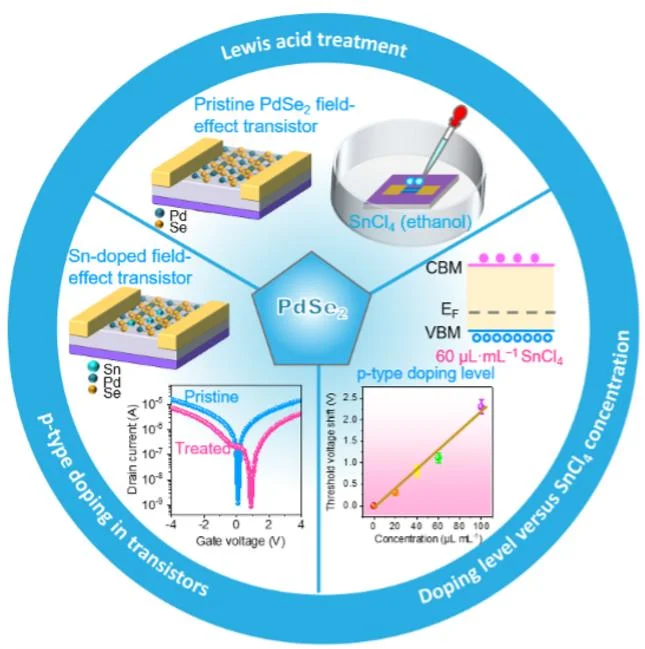Optoelectronics are utilized in a wide range of devices across numerous sectors, typically to detect or emit light. Historically, small transistors—small semiconductors constructed of graphene and other two-dimensional materials that regulate the flow of electrons and photons—have been the backbone of these devices. Still, band gap opening issues and other drawbacks with graphene and these other materials have triggered a search for substitutes.
 This graphic shows how the Lewis acid treatment, p-type doping, and tin chloride concentrations and their effects on palladium diselenide, used in transistors for optoelectronic devices. Image Credit: Yang Sha, Menghui Zhu, Kun Huang, Yang Zhang, Francis Moissinac, Zhizhou Zhang, Nano Research, Tsinghua University Press
This graphic shows how the Lewis acid treatment, p-type doping, and tin chloride concentrations and their effects on palladium diselenide, used in transistors for optoelectronic devices. Image Credit: Yang Sha, Menghui Zhu, Kun Huang, Yang Zhang, Francis Moissinac, Zhizhou Zhang, Nano Research, Tsinghua University Press
Palladium diselenide can be prepared via a process known as the Lewis acid treatment to meet the requirements of optoelectronic devices.
On November 24th, 2023, a study examining this technique was published in the journal Nano Research.
Palladium diselenide exhibits unique physical properties, including a tunable band gap and impressive device performance. Notably, it demonstrates long-term stability in ambient air without the need for additional packaging.
Dr. Mark H. Rümmeli, ERA Chairs Professor, Technical University of Ostrava
Drawing on concepts from semiconductor physics, the scientists explored the potential of enhancing palladium diselenide's functionality through doping. Doping refers to the deliberate addition of impurities to a substance, leading to the formation of three distinct material categories: unaltered (pristine), p-type doped, and n-type doped.
The interface formed by the contact between a p-type doped substance and an n-type doped substance is known as a p-n junction. This junction plays a crucial role in optoelectronic devices, serving as the critical point where the conversion of light to electrons and vice versa takes place.
Researchers employed the Lewis acid technique to produce p-type doped and n-type doped palladium diselenide in a controlled manner.
The controlled level of doping can make palladium diselenide have a different energy bandgap, which enriches a toolkit or library of materials for the selection and design of the p-n junction. The Lewis acid treatment can introduce the substitution of the palladium atoms (by tin from tin chloride, one type of Lewis acid) in the palladium diselenide. We found a data fitting equation between the doping level versus the concentration of Lewis acid, which may inspire people to manipulate more p-type doped two dimensional materials.
Dr. Hong Liu, Professor, State Key Laboratory of Crystal Materials, Shandong University
To validate their approach, the team first developed an untouched palladium diselenide film. This film underwent a modification process through a Lewis acid treatment. Following this initial treatment, the structural integrity of the palladium diselenide lattice remained intact. However, new peaks indicative of tin, palladium, and selenium were identified through imaging techniques, confirming tin's effectiveness as a p-type dopant.
Further experiments involving varying concentrations of tin chloride demonstrated the ability to manipulate the threshold voltage of the palladium diselenide, contingent on the tin chloride levels. This methodology offers a framework for future palladium diselenide doping with Lewis acids and could serve as a model for similar experiments on other semiconductor materials.
We will demonstrate the exciting applications of p-type doped palladium diselenide in several electronic components, such as field-effect transistors, photodetectors, and light emitters. We plan to try to optimize the semiconductor doping method, which can be readily adopted by industrial standards and could be employed in the semiconductor industry for mass production in the near future.
Dr. Jinbo Pang, Professor, Chemistry and Materials Science, University of Jinan
Dr. Pang continues, "Our ultimate goal is to apply this technique in wearable and flexible electronics by integrating the palladium diselenide-based transistors and photodetectors with polymer-based strain sensors in flexible substrates, which result in a smart biomedical system for human healthcare monitoring applications."
Jiali Yang and Dr. Weijia Zhou at the University of Jinan; Dr. Thomas Gemming at the Leibniz Institute for Solid State and Materials Research Dresden; Dr. Yu Liu at Soochow University; Dr. Jinshun Bi and Dr. Hao Jia at the Chinese Academy of Sciences; Dr. Alicja Bachmatiuk at the PORT Polish Center for Technology Development; En-Yang Wang and Dr. Shu-Xian Hu at the University of Science and Technology Beijing; Dr. Chongyun Jiang at Nankai University; Dr. Shirong Huang and Dr. Gianaurelio Cuniberti at the Technische Universität Dresden are the other contributors.
Major Innovation Project of Shandong Province, the National Science Foundation China, the Taishan Scholars Project Special Funds, the Foundation of State Key Laboratory of Biobased Material and Green Papermaking, the Natural Science Foundation of Shandong Province for Excellent Young Scholars, the State Key Laboratories of Transducer Technology fund, the National Key Research and Development Program, the National Natural Science Foundation of China, the the National Science Center and the Czech Republic under the ERDF program “Institute of Environmental Technology—Excellent Research,” and the Sino-German Research Institute supported the study.
Journal Reference:
Yang, J., et. al. (2023) Modulating p-type doping of two-dimensional material palladium diselenide. Nano Research. doi:10.1007/s12274-023-6196-7